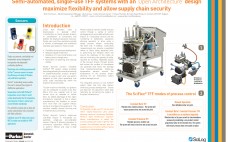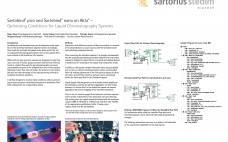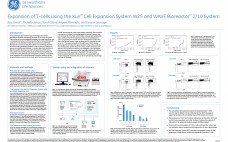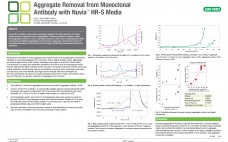Cross flow filtration used in bioprocesses is typically either microfiltration to clarify process streams or ultrafiltration to concentrate and diafilter the biopharmaceutical molecule. Single-use cross flow operations provide a number of advantages over traditional stainless steel systems. These include: • Flexibility during process development • Reduced capital investment • Avoidance of cross contamination and faster product change overs • Elimination of steaming and cleaning utilities Parker domnick hunter’s innovative SciFlex® TFF system utilizes propriety technology allowing the sterile processing of…
Thursday, October 24, 2013 Daily Archives
Sartobind® pico and Sartobind® nano on Akta® – Optimizing Conditions for Liquid Chromatography Systems
Sartobind pico and Sartobind nano are the laboratory-scale mem-bers of the Sartobind membrane adsorber family. Accordingly, their small size and high throughput make them perfect for use on automated chromatography systems such as the popular Akta series offered by GE Healthcare Life Sciences.While both the pico and nano capsules are designed for high flow rates, the array of valves, pumps, monitors and the flow restrictor found in a typical flow path for gel chromatography can cause unacceptable pressures at the…
The Importance of Thresholding in Imaging Analysis of Protein Aggregates
Dynamic imaging particle analysis (DIPA) shows much greater sensitivity to transparent particles, such as protein aggregates, than light obscuration can. While not yet fully accepted in industry compendia, DIPA is being used increasingly in the formulation process for characterization of sub-visible particulates in biologics. DIPA measures particle size and shape by first creating a binary image based upon a defined threshold from the background value for each pixel in the image. The resulting binary image is used for all particle…
Enhancing Efficiency and Economics in Process Development and Quality Control of Biotherapeutics
Analytical techniques that measure protein quantity and quality are used in nearly all stages of research, process development, quality control and manufacturing of biotherapeutics. UV spectroscopy, ELISA and HPLC have been in use for decades for protein quantitation in physiological and process samples, and continue to be the workhorses despite their many limitations. Biopharmaceutical companies have enthusiastically adopted Pall ForteBio’s Octet® systems due to their high throughput capabilities, decreased sample preparation requirements, and low cost of operations. The Octet systems…
Expansion of T-cells using the Xuri Cell Expansion System W25 and WAVE Bioreactor 2/10 System
Immunotherapeutics include drugs and biologics that render therapeutic benefit by harnessing the power of the immune system. The promise of immune-mediated therapies is to target specificity with a consequent reduction in off-therapeutic effects. Immunotherapeutic products can be classified broadly into (1) active immunotherapy (therapeutic vaccines), (2) adoptive cellular immunotherapy (transfer of immune cells, genetically modified T-cells or precursor cells) or (3) passive immunotherapy (antibody or receptor ligand administration). Recent scientific advances have led to clinical trials of both active and…
Aggregate Removal from Monoclonal Antibody with Nuvia™ HR-S Media
Nuvia HR-S media is a new cation exchanger designed for high resolution of closely related product impurities such as aggregates. It delivers excellent resolution, with a final aggregate content of <0.3%, and high recovery of >80% from a heterogeneous feed of monoclonal antibody aggregates and monomer. Aggregate content and recovery in the eluate were shown to be functions of the target conductivity measured at the end of collection.






